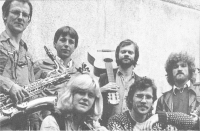| Dan Lundberg: Swedish folk Music - from village greens to concert platforms | |||
|
|
|||
|
New folk music instruments |
|
|
|
|
NEW FOLK MUSIC INSTRUMENTS
Balladen om Vallevan. Filarfolket 'Utan tvekan' (AMCD29) The new common denominator in these groups was the great variety of
instruments; several of the players were also multi-instrumentalists. It
is noticeable that the separation between the “original” folk music
version and the “new” version which was clearly distinguishable in the
arrangements of Gråtlåten and I fjol så gick jag med herrarna i
hagen is less in evidence or lacking entirely. |
|
New folk music instruments |
|
|
|
|
|
|||
| Dan Lundberg: Swedish folk Music - from village greens to concert platforms | |||
 Two influential groups from this decade were
Filarfolket (picture) (1980-90) and
Groupa (1980-). What above all distinguished the sound of these groups
from earlier folk music bands was the use of wind instruments (saxophones,
clarinets and trumpets) in combination with percussion (mainly
miscellaneous striking apparatus with folk music origins). With woodwind
and percussion in the foreground, Filarfolket experimented with “riffs”
(rhythmic and melodic ostinati) as an accompaniment to folk tunes.
Two influential groups from this decade were
Filarfolket (picture) (1980-90) and
Groupa (1980-). What above all distinguished the sound of these groups
from earlier folk music bands was the use of wind instruments (saxophones,
clarinets and trumpets) in combination with percussion (mainly
miscellaneous striking apparatus with folk music origins). With woodwind
and percussion in the foreground, Filarfolket experimented with “riffs”
(rhythmic and melodic ostinati) as an accompaniment to folk tunes.